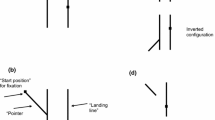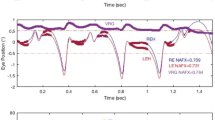Summary
Dynamic overshoot is a small saccade that follows a main saccade, in the opposite direction, with no delay. To re-examine prior reports of dynamic overshoot, the properties of dynamic overshoot were studied in six normal subjects. The postsaccadic drift of eye movements was studied as well. Horizontal eye movements were recorded with the magnetic-field/search-coil method. System noise level was 0.05 deg. Dynamic overshoot occurred with a frequency of about 13% and was more frequent for saccades 10 deg or less. Its mean size was 0.15 deg and its peak velocity showed it to be saccadic in nature. Binocular recordings for three subjects showed that when dynamic overshoot occurred it was almost always in the abducting eye which also had the least post-saccadic drift. The adducting eye seldom had dynamic overshoot and consistently had a more pronounced post-saccadic drift, almost always in the onward direction. We suggest that, at the end of a saccade, the eye normally is brought to rest by a braking pulse and dynamic overshoot occurs when the braking pulse is accidentally too large. It would appear to serve no useful purpose. Why dynamic overshoot is monocular and coincides with the eye having less post-saccadic drift is unclear.
Similar content being viewed by others
References
Bahill AT, Clark MR, Stark L (1975a) Dynamic overshoot in s'accadic eye movements is caused by neurological control signal reversals. Exp Neurol 48: 107–122
Bahill AT, Clark MR, Stark L (1975b) Computer simulation of overshoot in saccadic eye movements. Computer Programs Biomed 4: 230–236
Cannon SC, Robinson DA (1985) Neural integrator failure from brain-stem lesions in monkey. Invest Ophthalmol Vis Sci (Suppl) 26: 47
Collewijn H, van der Mark F, Jansen TC (1975) Precise recordings of human eye movements. Vision Res 15: 447–450
Fuchs AF, Kaneko CRS, Scudder CA (1985) Brainstem control of saccadic eye movements. In: Cowan WM (ed) Ann Rev Neurosci, Vol 8, Palo Alto, pp 307–337
Goldstein HP (1983) The neural encoding of saccades in the rhesus monkey. Ph. D. dissertation, The Johns Hopkins University
Hays AV, Richmond BJ, Optican LM (1982) A UNIX-based multiple process system for real-time data acquisition and control. WESCON Conf Proc, pp 2/1-1 to 2/1-10
Kenyon RV, Stark L (1983) Unequal saccades generated by velocity interactions in the peripheral oculomotor system. Math Biosci 63: 187–197
Robinson DA (1963) A method of measuring eye movement using a scierai search coil in a magnetic field. IEEE Trans Bio Med Elect BME-10: 137–145
Robinson DA (1981) Control of eye movements. In: Brooks VB (ed) Handbook of physiology, Vol II, Part 2, The nervous system, Am Physiol Soc, Williams & Wilkins Co, Baltimore, pp 1275–1320
Sindermann F, Geiselmann B, Fischler M (1978) Single motor unit activity in extraocular muscles in man during fixation and saccades. Electroencephalogr Clin Neurophysiol 45: 64–73
Steinman RM (1965) Effects of target size, luminance, and color on monocular fixation. J Opt Soc Am 55: 1158–1165
van Gisbergen JAM, Robinson DA, Gielen S (1981) A quantitative analysis of generation of saccadic eye movements by burst neurons. J Neurophysiol 45: 417–441
Vilis T, Snow R, Hore J (1983) Cerebellar saccadic dysmetria is not equal in the two eyes. Exp Brain Res 51: 343–350
Westheimer G, McKee SP (1975) Visual acuity in the presence of retinal-image motion. J Opt Soc Am 65: 847–850
Author information
Authors and Affiliations
Additional information
Dr. Kapoula is a visiting scientist from the Laboratoire de Psychologie Expérimentale, Université René Descartes, 28, Rue Serpente, F-75006 Paris, France
Rights and permissions
About this article
Cite this article
Kapoula, Z.A., Robinson, D.A. & Hain, T.C. Motion of the eye immediately after a saccade. Exp Brain Res 61, 386–394 (1986). https://doi.org/10.1007/BF00239527
Received:
Accepted:
Issue Date:
DOI: https://doi.org/10.1007/BF00239527




